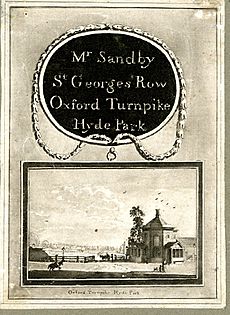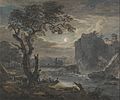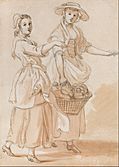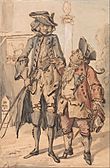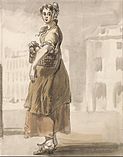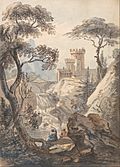Paul Sandby facts for kids

Paul Sandby (born 1731 – died 1809) was a famous English artist. He started his career making maps. Later, he became a well-known landscape painter, especially using watercolours. Paul and his older brother, Thomas, were important artists. They helped start the Royal Academy in 1768.
Contents
Paul Sandby's Life and Art
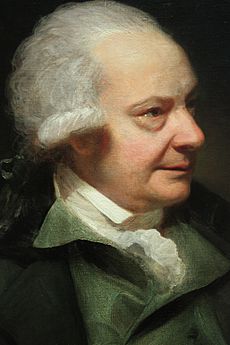
Paul Sandby was born in Nottingham in 1731. When he was about 14 years old, in 1745, he moved to London. There, he joined his brother Thomas in a military drawing job at the Tower of London.
Early Career in Scotland
After a big event called the Jacobite rebellion of 1745 ended, Sandby got a special job. He helped survey new roads and forts in the Scottish Highlands. He was later made the main draughtsman for this survey.
While working, he started drawing landscapes in watercolour. These drawings showed how Scotland was changing after the rebellion. He also sketched important events, like a public hanging in Edinburgh in 1751. In Edinburgh, he loved to sketch the city's views. One of his famous drawings, West View of the City of Edinburgh, is now in the Scottish National Gallery of Modern Art.
Moving to Windsor
In 1751, Sandby left his job with the survey. He then lived with his brother Thomas at Windsor Great Park. Thomas was in charge of the park. Paul helped his brother and drew many pictures of Windsor Castle and the area around it. A rich man named Sir Joseph Banks bought these drawings.
Other artists, like Thomas Gainsborough, praised Sandby's skills. In 1764, Gainsborough said that Sandby was the best artist for "real Views from Nature in this Country."
Etchings and Caricatures
Sandby also made many etchings from his own drawings. An etching is a type of printmaking. In 1765, he published a book with a hundred of these etchings, including views of Edinburgh. In 1760, he created twelve etchings called The Cries of London. These showed street sellers and their calls.
He also made funny drawings called caricatures. Some of these made fun of another famous artist, William Hogarth. He continued to create satirical art throughout his life.
Family Life and Royal Academy
It's not clear how long Sandby lived at Windsor. But he spent part of each year in London. He also traveled a lot to sketch. On May 3, 1757, he married Anne Stogden. By 1760, he was living in London.
In 1760, he showed his art at the first exhibition of the Society of Artists. He exhibited there regularly. In 1768, he became the chief drawing master at the Royal Military Academy in Woolwich. He kept this job until 1799.
In the same year, 1768, the Royal Academy was formed. King George III chose Sandby as one of its 28 founding members. Sandby often helped run the Academy. He showed his art in almost all of their exhibitions between 1769 and 1809.
Travels and Later Life
Sandby traveled widely across Britain and Ireland. He sketched beautiful scenery and old buildings. His first trip to Wales was in 1770. Later, in 1773, he toured south Wales with Sir Joseph Banks. This trip led to him publishing XII Views in South Wales in 1775. He published another 12 views the next year. These were part of a 48-plate series of aquatint engravings showing Welsh scenery. Sir Joseph Banks had asked him to create these.
Paul Sandby died at his home in Paddington on November 7, 1809. He was buried in the burial ground of St George's, Hanover Square. People remembered him as "the father of modern landscape painting in watercolors."
Gallery
-
- Windsor Castle: View of the Round and Devils Towers from the Black Rock
-
Harlech Castle by Paul Sandby 1776
See also
 In Spanish: Paul Sandby para niños
In Spanish: Paul Sandby para niños
- English school of painting


